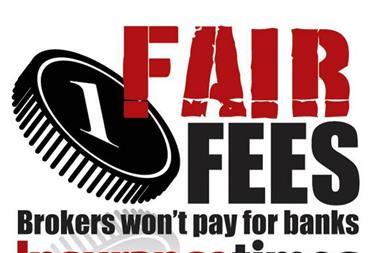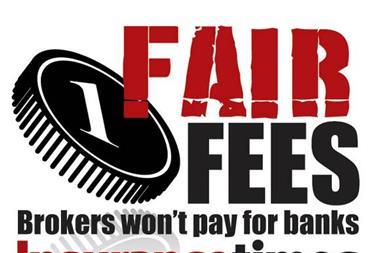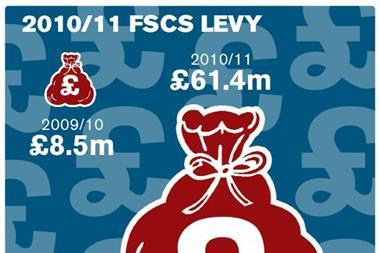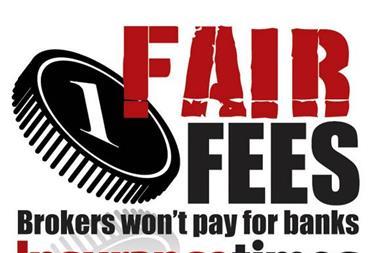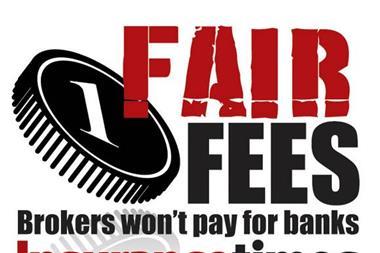As Insurance Times’s Fair Fees campaign gains pace, we outline the history of the PPI mis-selling debacle
• Distributors, predominantly large banking groups, many of which are vertically integrated with both insurance and banking businesses, held a pivotal role in the design, pricing and sale of PPI products.
• Twelve distributors were responsible for 85% of sales between 2006 and H1 2008. Insurance companies competed for contracts of pooled PPI risks put out to tender by distributors.
• Profit levels from PPI sales were high for distributors (up to 80%), although evidence suggests that some of these earnings were used to cross-subsidise sales of credit products. There is no evidence that PPI was abnormally profitable for insurance companies.
• Distributors used credit intermediaries for a portion of PPI sales but, unless tied, these businesses were free to source credit products from one distributor and PPI from another. Many intermediaries' businesses have been affected as a result of the slump in availability of consumer credit products and some have folded.
• 70% of consumer PPI complaints to the Financial Ombudsman Service (FOS) between March 2009 and March 2010 were about banks; 22% about intermediaries (many classified by the Financial Services Compensation Scheme (FSCS) as insurance intermediaries); 4% about general insurers; and 4% other.
• The vast majority of complaints to the FOS have been about the mis-selling of PPI products paid with a single premium. Claims management companies were involved in six out of 10 new cases about PPI in 2009/10, with seven claims management companies accounting for 52% of all cases.
What is payment protection insurance and why is it an issue?
PPI protects a borrower's ability to maintain loan payments in the event of accident, sickness and/or unemployment and, under some policies, death. Policies are available to protect most forms of personal credit, the main ones being mortgages (first and second charge), unsecured loans and credit and store cards.
But it is a secondary insurance product typically bought by consumers as a result of buying a primary product, such as a mortgage or unsecured loan. This means that it was normally sold by credit providers/intermediaries rather than insurance providers/intermediaries.
Following investigations into the sale of PPI by the Office of Fair Trading (OFT) and the Competition Commission, the number of complaints to the FOS about the sale of PPI has risen dramatically in recent years. The FOS reported in its March 2010 review that it had upheld 94% of these complaints against intermediaries selling PPI insurance during the previous year, and issued financial remedies. Five credit intermediaries, all since out of business, have been found responsible for the vast majority of intermediary PPI mis-selling.
The consequence has been a dramatic rise in the levy on insurance intermediaries by the financial regulator, the FSA; the levy includes a portion collected by the FSA to finance the FOS service and the funds distributed by the FSCS used when consumer compensation is due and the guilty financial services business is no longer trading. Since credit brokers also sell insurance products, they are classified as part of insurance for the purposes of the FSCS compensation.
The PPI story
Following a super-complaint from the Citizens Advice Bureau in 2005, the OFT launched a market study into the PPI market in 2006 to determine how well it delivered choice and value for money for consumers. The OFT concluded that despite there being a sizeable market, with gross premiums estimated at £5.5bn in 2005, consumers were poorly served.
Premium income paid out in claims was of the order of 20% (compared to over 74% for motor insurance claims and over 55% for household insurance claims at that time) and there was evidence that competition was hindered as a result of how consumers purchased their PPI, their understanding of the product and the information available about the product.
The reasons for this were complex. This was a market where the product claims ratios were below 30%, leaving over 70% of net premiums to cover the costs (and profits) of underwriters and distributors. Competitive pressures between insurers providing PPI policies for distributors did appear to be operating but there was little evidence that distributors were passing this benefit on to consumers.
The OFT referred the issue to the Competition Commission in February 2007, requesting that the Commission investigate the supply of PPI for all markets except store card PPI. (Store card PPI had been the subject of an earlier PPI investigation by the Commission.)
The Competition Commission's final report and recommendations, published in January 2009, concluded that there was little retail competition for the sale of PPI products when sold in combination with the credit that it insures; there were features in the part of the market served by distributors and their intermediaries that led to an adverse affect on competition and resulted in consumers facing higher prices and less choice than they would have done if there was effective competition between providers.
However, the Commission also concluded that the wholesale market, the insurance underwriters' part of the market, although relatively concentrated, offered no restraints on competition and should therefore not be subject to remedies.
In 2009, the Competition Commission recommended a package of remedies that directly affected PPI retail distributors and intermediaries. Barclays Bank supported by Lloyds Banking Group and Shop Direct Group Financial Services Ltd, contested through the courts the imposition of some remedies.
This has slowed down implementation of remedies that included the prohibition of PPI at the point of credit sale, now banned, and prohibition of single premium PPI policies where the premium is paid in one upfront payment, generally by adding the premium to the credit borrowed. Lloyds Banking Group has since announced its exit from PPI sales and Barclays recently lost its court case, which is likely to lead to the single premium PPI policy ban in autumn 2010.
PPI value chain
The 2009 Competition Commission report provides considerable insight into distribution of PPI policies. Click on the pdf 'Figure 1-PPI chain' in related files for more details, as well as the Competition Commission's figures on main 12 major distributors of PPI.
Distributors used intermediaries for some PPI sales (the exact volume was not identified in the Competition Commission report). Intermediaries marketed credit products and PPI products on behalf of distributors, often selling the consumer a credit product from one distributor and a PPI product from another.
Often referred to as IFAs (individual financial advisers) or mortgage brokers, they are regulated by the FSA and their industry structure to a very large extent mirrors that of insurance brokers; some act independently, others are members of networks, while others are tied to distributors. This part of the market has been severely impacted by the severe downturn in the housing market and several intermediaries have since gone out of business.
PPI profitability
Distributors, in their pivotal role set PPI premiums ensuring they were contractually entitled to a percentage of GWP. At the time of the Competition Commission report, typical commission rates were 50%-80% for personal loan and credit card PPI and 40%-65% for mortgage PPI. The remaining GWP was passed to the underwriter to cover expenses including claims.
In the event that claims levels were less than expected, the resulting profit was typically split between underwriter and distributor according to an agreed profit share percentage, typically 90%-100% in favour of the distributor. A separate profit share arrangement was typically applied to any investment income earned by the underwriter on premium income.
The Competition Commission created a model of economic profitability for distributors from PPI sales. It concluded that the profits from PPI were high while the distributors' associated costs were low. For example, for 2006 it was estimated that the 12 largest distributors made an economic profit of £1.4bn from sales of PPI, representing a RoE of 490%.
But this did not always go straight to the companies' bottom lines as there was evidence that profits from PPI were cross-subsiding the costs of credit products being sold alongside the PPI products in the highly competitive consumer credit markets of the time.
Consumer complaints and the role of the FOS
The consumer credit market sales frenzy reached its zenith in 2007-08 and in its aftermath the stories of mis-selling of PPI began to emerge with increasing frequency. Consumer PPI complaints are handled by the FOS. The March 2010 FOS review noted a 38% increase in new consumer complaints about insurance as a whole, with 30% (49,193) of these new cases about PPI.
The vast majority of complaints were about the sale of policies paid with a single premium, in other words the upfront cost was added to an unsecured or second-charge loan.
A significant number of other cases related to the sale of PPI alongside credit cards, while mortgage PPI did not give rise to a significant number of complaints. Figure 2 shows how the number of new PPI complaints to the FOS has risen in recent years - click on the image on the right to view.
During the 2009/10 period, 70% of PPI complaints were about banks, 22% were about insurance intermediaries, 4% about general insurers and 4% other.
Claims management companies were involved in six out of 10 new cases about PPI brought to FOS during the year, with seven claims management companies accounting for 52% of all cases. The other 48% involved a further 150 claims management companies.
Conclusions
The insurance brokerage industry is paying dearly for this sorry tale as it picks up the tab for compensation costs awarded to consumers on behalf of defunct intermediary credit businesses following industry agreed default compensation arrangements. The Insurance Times Fair Fees campaign is part of the efforts to address this issue.
However, judging by the number of FOS-handled PPI complaints in total, the mis-selling scandal has also had an impact on banks but these firms have sufficiently strong balance sheets, albeit with government support in some instances, that they are able to meet compensation payments.
But could the insurance industry find itself at the mercy of the actions of the credit (banking) industry again in the future? The answer is yes. Large financial services groups – identified as distributors in this note – that are able to generate profits from the synergies of the banking and insurance sides of their businesses could create new products that cause future problems.
But the insurance industry also benefits from the product innovations that result. The debates about the size and structure of financial services groups will rumble on. Sound and effective industry regulation remains a vital ingredient for all.
From where can more detailed information about the PPI issue be obtained?
There are several sources of information about the PPI issue:
1) OFT: http://oft.gov.uk/advice_and_resources/resource_base/market-studies/completed/payment
2) OFT PPI report: http://www.oft.gov.uk/shared_oft/reports/financial_products/oft869.pdf
3) Competition Commission: http://www.competition-commission.org.uk/inquiries/ref2007/ppi/index.htm
4) Competition Commission - company synopses of PPI providers: http://www.competition-commission.org.uk/rep_pub/reports/2009/fulltext/542_2_7.pdf
5) Competition commission final report: http://www.competition-commission.org.uk/rep_pub/reports/2009/542ppi.htm
6) Competition Commission Tribunal: http://www.catribunal.org.uk/237-3732/1109-6-8-09-Barclays-Bank-PLC.html
7) Competition commission: Response to Barclays appeal – http://www.competition-commission.org.uk/inquiries/ref2007/ppi/pdf/ppi_remittal.pdf
8) Competition Commission: PPI Remittal plans – http://www.competition-commission.org.uk/inquiries/ref2007/ppi/pdf/ppi_remittal.pdf
9) FSCS levy information: http://www.fscs.org.uk/industry/funding/levy-information/
10) FOS annual reviews: http://www.fos.org.uk/publications/annual-reviews.htm
11) FOS funding: http://www.fos.org.uk/faq/businesses/funding.html
Downloads
Figure1-PPI chain
PDF, Size 78.78 kb
Hosted by comedian and actor Tom Allen, 34 Gold, 23 Silver and 22 Bronze awards were handed out across an amazing 34 categories recognising brilliance and innovation right across the breadth of UK general insurance.






































